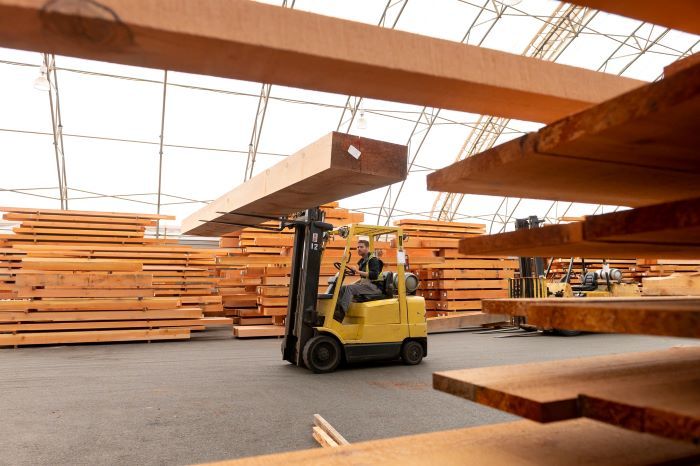Blog
Insurance for Mass Timber Manufacturers: 5 Ways to Customize Your Coverage
The right insurance coverage is critical for all businesses, and mass timber manufacturing is no exception. The complex and unique exposures mass timber manufacturers face creates a wide scope of insurance needs that vary by the size of the company and what is being manufactured.

All mass timber manufacturing companies should have property, general liability (GL), and auto liability insurance. Beyond those general headings, each company needs to individualize its coverage to protect its specific risks.
This article explores five insurance considerations all mass timber manufacturers should be mindful of and discuss with their insurance or risk management professional.
1. General Liability Products-Completed Operations Coverage: What Worries Underwriters
General liability policies for manufacturers include “products-completed operations” coverage for third-party bodily injury and property damage claims that arise from a finished product or work. However, not all manufactured products are viewed the same by general liability underwriters.
For mass timber products in North America, many mainstream insurance carriers share the view that products and technologies in the space are still “newer” and “untested.” These carriers have scant knowledge about mass timber products such as cross-laminated timber (CLT) or glue-laminated timber (glulam), or they group mass timber in the same class as “light-frame wood” when it comes to codes and fire ratings.
| Changing the perception of insurance underwriters in an entire industry segment is like turning a cruise ship using a single tugboat: It will take a lot of effort and commitment but will start slowly and pick up momentum over time. |
For the mass timber industry, it will take a combination of ongoing product development and improvements as well as cohorts of mass timber and insurance industry professionals and experts to combine forces to educate stakeholders on product development, value proposition, and risk.
The enhancements that have already been made as well as current educational initiatives in the mass timber space over the past five to 10 years have already led mainstream insurance carriers to show interest and shift perceptions on mass timber products. However, each product and manufacturer is unique and must tell its own story.
To best present themselves in the eyes of general liability insurance carriers, and to obtain more favorable pricing, we recommend that mass timber manufacturers:
- Provide carriers with information—a lot of it. Provide a transparent and detailed story about the history of your product and your manufacturing process.
- Provide carriers with details of your quality control process. Outline steps taken at each quality control level, the purpose of those steps, and even checklist sheets of what is being reviewed and analyzed.
- Have an open dialogue with carriers on what is causing them concern, such as the combustibility or delamination potential of your product. Address those concerns directly.
- Host a tour at your site with your insurance carriers. If a picture is worth a thousand words, imagine the impact of a tour.
- Test products regularly and often. Publish your test results.
- Provide underwriters with test results of other similar products. This should ease the over-arching misconception of your product.
- Educate the carrier. For example: What building codes are out there for your products that you are meeting/exceeding?
- Engage in this conversation with your broker throughout the year. Don’t wait until the time of renewal.
2. Professional Liability Coverage: Product Guidance Leads to Exposure
One exposure excluded from a traditional general liability policy is liability from consultative services or design/drafting services specific to the product your company manufactures. Also known as errors and omissions (E&O) insurance, a professional liability policy can protect mass timber manufacturers from claims of negligence, errors in services given, omissions, misrepresentation, or inaccurate advice when consulting about the design or implementation of their product.
As the mass timber industry is quickly evolving, architects, contractors, and owners are becoming more innovative with their designs and must think about how they are building them, whether their designs will be effective, and which products to use.
| New products and methods are entering the mass timber space regularly, so industry professionals must lean on mass timber manufacturers to help them better understand how to use the product and put it in place. If manufacturers give any kind of advice or guidance on how to use their product, this could create E&O exposure. |
As more mass timber manufacturers become involved in design, they’ll need this critical protection. If you must explain what and how to use your new product, talk to a broker first to understand:
- How much guidance should be given
- How involved you are in the design
- Potential exposures
- How to ensure coverage for potential damages or injuries
3. Stock Throughput Policy: Coverage for Transport & Storage
Many manufacturers routinely transport their products from supplier to manufacturer and from storage to the construction site. But did you know that a standard property policy doesn’t always cover the transfer or storage of your stock at different locations?
A stock throughput policy provides this important coverage. It integrates transportation, inventory storage, material handling, and packaging to cover any repositioning of raw materials, works in progress, and finished products.
A stock throughput policy ensures coverage for your products in transport from the supplier to when you receive materials, through the manufacturing process, and to when you hand them off to the customer. This includes the products being on your site, or if you need to store the product offsite for a specified amount of time. With the current upheaval in the property insurance market, a stock throughput policy gives you the option to reduce your overall premium spend by carving out stock from your property insurance policy. Oftentimes, you can achieve lower deductibles for transit and inventory exposures. Additionally, the property and STP programs have their own dedicated catastrophe limits thereby increasing your combined catastrophe insurance coverage.
4. Cyber Liability Policy: Protection Against Cyberattacks
In today’s world, cyber liability coverage is something every business in every industry must consider. Cyberattacks can affect mass timber manufacturers from all angles, including shipping, billing, and e-mail correspondence.
Ransomware attacks, where cybercriminals hold your operational technology (machinery, systems, etc.) hostage by attacking through your internet technology (tech connected to internet) until you pay a ransom, is more prevalent than ever. The costs associated with a cyber event for mass timber manufacturers can be vast and may include, but is not limited to, business interruption, physical damage to equipment/systems, the arduous process of remediation and getting systems back online, and the cost to deal with threat actors or violations of privacy laws. Having cyber liability insurance in place will help protect your company from these exposures and keep it operational after a cyberattack.
This policy can be tailored to your needs and cover the following areas:
- Indemnification for legal fees and expenses
- Customer notifications of a breach
- Option to monitor the information of anyone impacted by a breach
- Cost of the recovery of compromised data
- Repair costs of damaged computer systems
5. Directors and Officers (D&O) Policy: Attract and Retain Leadership
Whether your mass timber company is large or small, or publicly or privately held, your company leaders and investors can be at risk.
D&O insurance is a crucial way to protect your leaders in the event legal action is brought against them or the company. In fact, most effective leaders will only join your organization if they are provided D&O coverage.
We recommend you work with a broker who understands the needs and potential exposure of your directors and officers and the specifics of what your D&O policy should include.
How to Determine the Coverage You Need
Buying every available coverage out there is neither practical nor necessary. Rather than wasting your time and money on policies you don’t need in an impossible attempt to cover all risks, we recommend you think about insurance differently.
Begin by asking your broker specific questions that apply to your operation. Are we covered in this scenario, and how are we protected? Do we need additional coverage in this particular area? What steps can we take to mitigate our exposure? Your broker should actively and regularly be having these conversations with you and have the knowledge to recommend adjustments to your policies as your business needs and goals evolve.
As your mass timber business changes and grows, routinely review available coverage options, assess potential risks, and consult with a trusted broker to ensure your assets and operations are adequately protected.
Author
Table of Contents














